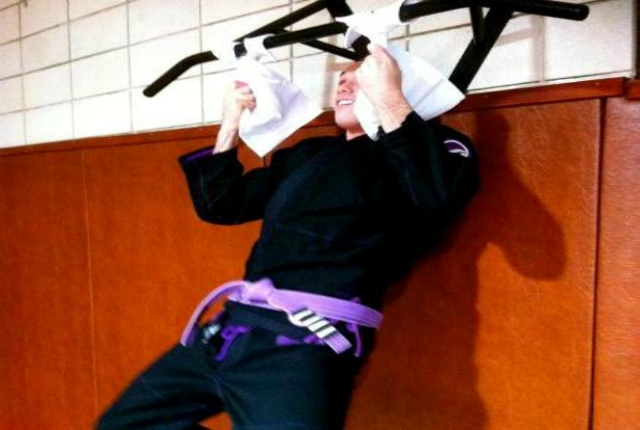Establishing good grips in BJJ and Judo is so important as very often when you dominate the grip battle and establish your dominant grips you can control and dominate your opponent. I personally work my grips by climbing rope and doing pull ups with my gi. I also rock climb whenever I have the time. Many top BJJ players use rope climbing as a staple of their daily training. Fernando Margarida was said to have spent at least an hour per day on his rope training.
Pull ups are also one of the best ways to build upper body strength.
In a sport like Jiu-Jitsu were you are constantly pulling, grabbing and holding your opponent having grip strength and endurance is very important.
Enhancing Jiu-Jitsu Performance with Pull-Ups: A Strength Training Perspective.
Pull-ups, a fundamental strength training exercise, are often touted as a valuable tool for enhancing Jiu-Jitsu performance. We will dissect the importance of pull-ups and provided insights into how practitioners can develop this vital skill.
The Importance of Pull-Ups in Jiu-Jitsu
Pull-ups are considered an essential upper body strength exercise for grappling sports like Jiu-Jitsu. They not only build significant upper body and grip strength but also contribute to overall athletic development. The movement’s emphasis on pulling strength aligns with the demands of Jiu-Jitsu, which requires athletes to have a strong grip and the ability to control and manipulate an opponent’s body.
Going from Zero to Hero in Pull-Ups
For many, achieving even a single pull-up can be a daunting task. The discussion highlighted a progressive approach to developing the ability to perform pull-ups. Beginners are encouraged to start with simpler exercises like ring rows or seated rows to build foundational strength. Over time, they can progress to more challenging variations and eventually full pull-ups.
The Role of Full Range of Motion and Eccentrics
It is very important to achieve a full range of motion in pull-ups, moving beyond just getting the chin over the bar to bringing the chest to the bar. This extended range of motion indicates healthy shoulder mobility and increased muscle engagement. Eccentric pull-ups, where the practitioner focuses on the lowering phase of the movement, are identified as particularly effective for building strength, especially for those who cannot yet perform a concentric pull-up.
Addressing Common Challenges in Pull-Up Training
There are also common challenges faced by individuals trying to improve their pull-up performance. These include the tendency to neglect the activation and movement of the shoulder blades and the over-reliance on assistance machines and bands, which can alter the natural mechanics of the movement. Instead, a focus on time under tension, isometric holds, and eccentric loading is recommended to build true pulling strength and shoulder stability.
The Psychological and Practical Benefits
Beyond physical strength, mastering pull-ups is a liberating and empowering experience, providing a sense of athletic achievement. Practically, the ability to pull one’s body weight has real-world applications, such as in self-defense scenarios, where escaping danger might require climbing or pulling oneself up.
Pull-Ups as a Key Component of Jiu-Jitsu Training
The incorporation of pull-ups into a Jiu-Jitsu athlete’s training regimen can lead to significant improvements in grip strength, upper body power, and overall athletic performance. Through a structured and progressive approach, even those unable to perform a single pull-up can develop the strength and technique required to master this challenging but rewarding exercise. The benefits extend beyond the mats, contributing to a practitioner’s overall physical preparedness and mental resilience.
Stephan Kesting demonstrates 19 pull-up variations he uses in conditioning for BJJ and submission wrestling:

















